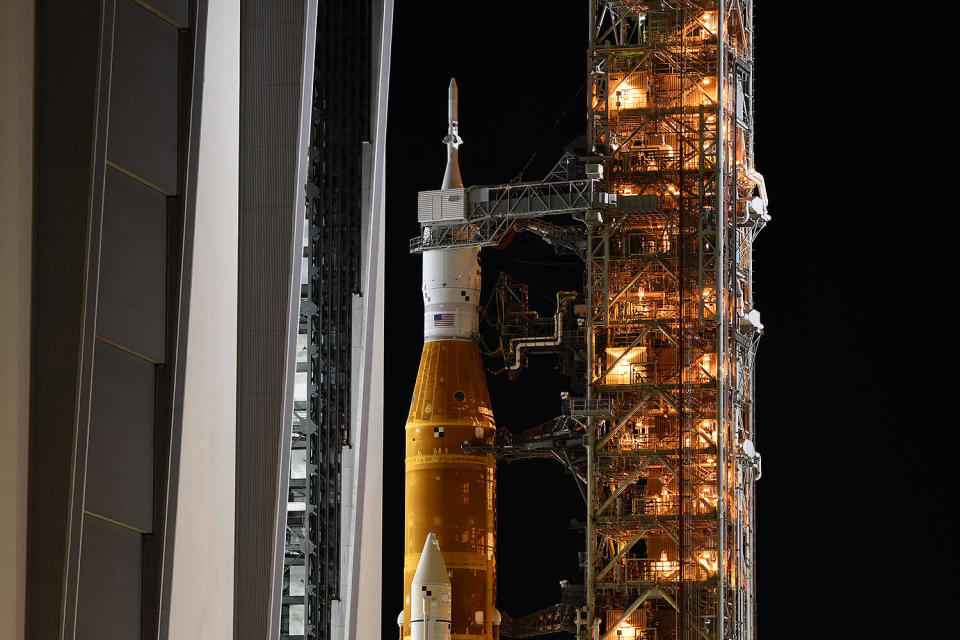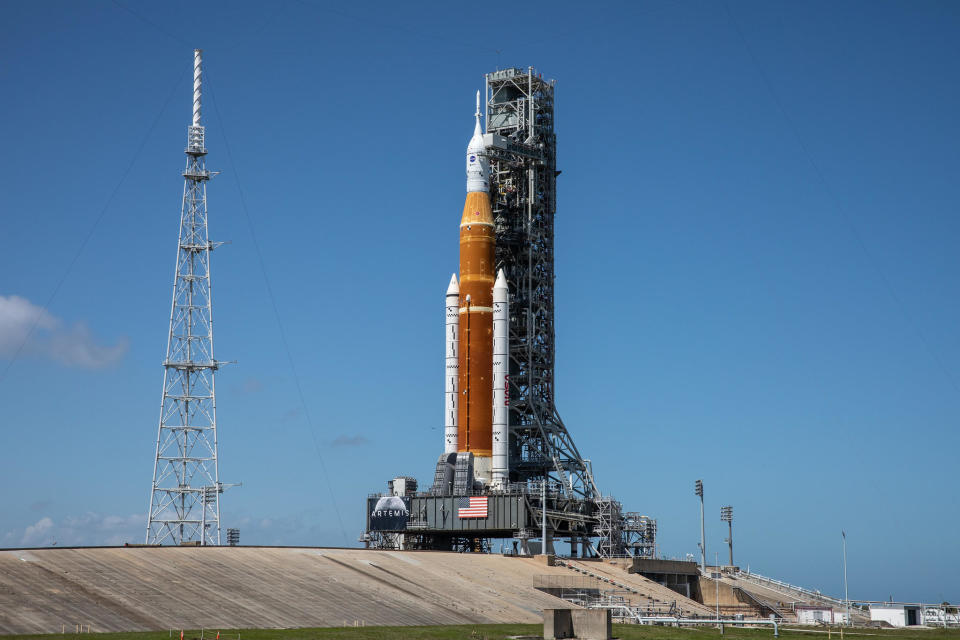NASA rmoves SLS moon rocket rollout back to launch pad
NASA's $4.1 billion Space Launch System moon rocket was hauled out of the iconic Vehicle Assembly Building Tuesday at the Kennedy Space Center in Florida for a 4.2-mile overnight trip to pad 39B, setting the stage for a long-awaited maiden flight to send an unpiloted Orion deep space crew ship on a voyage around the moon.
A powerful Apollo-era crawler-transporter, carrying the 3.5-million-pound, 322-foot-tall SLS rocket, and its 10.5-million-pound mobile launch platform, began inching its way out of the Kennedy Space Center's cavernous VAB at 9:55 p.m. EDT, cheered on by hundreds of spaceport workers and family members.

Rollout began about an hour late because of nearby thunderstorms, but the trip was expected to be complete by around 7 a.m. Wednesday. Once the mobile launcher is lowered onto pedestals atop the pad, engineers will connect power, data, propellant lines, water lines and other systems to prepare the rocket for exhaustive pre-launch tests and checkout.
If all goes well, the team will start a 46-hour, 10-minute countdown at 10:23 a.m. EDT Aug. 27, setting the stage for blastoff at 8:33 a.m. on Monday, Aug. 29, kicking off a 42-day flight to send an unpiloted Orion crew capsule around the moon and back.
Backup launch opportunities, based on the ever-changing positions of Earth and the moon, along with the need to replenish spaceport propellant supplies, are available Sept. 2 and 5. After that, NASA would have to haul the SLS back to the VAB to service batteries and other systems, delaying launch to later this fall.
The goal of the Artemis 1 mission is to verify the SLS's performance, test the solar-powered Orion crew capsule in deep space and confirm its 16.5-foot-wide heat shield will protect the ship during a hellish high-speed plunge back into Earth's atmosphere at the end of the flight.
Assuming an on-time launch, the Orion capsule will target splashdown in the Pacific Ocean west of San Diego at 11:53 a.m. EDT on Oct. 10.
If the test flight goes well, NASA plans to launch four astronauts on the SLS rocket's second flight in 2024 — Artemis 2 — followed by a third mission that will send the first woman and the next man to the moon's surface in the 2025-26 timeframe.

The SLS is the most powerful operational rocket in the world, using two lengthened shuttle-heritage solid-fuel boosters and four upgraded shuttle-era RS-25 engines to generate a combined 8.8 million pounds of thrust at liftoff, 15% more than NASA's legendary Saturn 5 moon rocket.
In its initial "block 1" configuration, the SLS is capable of boosting nearly 30 tons to the moon. Planned variants, using a more powerful upper stage and advanced boosters, will be capable of sending nearly 50 tons to the moon in a single flight.
SpaceX is building a larger, more powerful Super Heavy-Starship rocke with double that capability, but it can't do it in a single flight. The reusable Starship is designed to be refueled in Earth orbit before departing for deep space.
NASA carried out a full-duration test firing of the Boeing-built SLS core stage and its four Aerojet Rocketdyne RS-25 engines at the Stennis Space Center in Mississippi last year. The booster then was shipped to Florida where the rocket's second stage, provided by United Launch Alliance, and the Lockheed Martin-built Orion capsule were attached.
Engineers carried out four dress-rehearsal countdowns to clear the way for launch, but the tests were marred by ground-system problems, a stuck helium valve and two troublesome hydrogen leaks, one where the main fuel line connects to the base of the core stage and another in a smaller fitting used to help chill the main engines.
Hydrogen leaks are notoriously difficult to isolate and fix because they only show up when ultra-cold propellant is flowing through the lines and fittings. Repairs have to be carried out at room temperature.
Engineers successfully repaired the umbilical fitting, which worked normally during a subsequent fueling test. But the main engine "bleed" line, repaired in the VAB after the most recent countdown rehearsal, has not yet been re-tested under cryogenic conditions. That won't happen until the SLS is fueled for launch on Aug. 29.
Mom teaches 5-year-old son what to do during a school shooting

